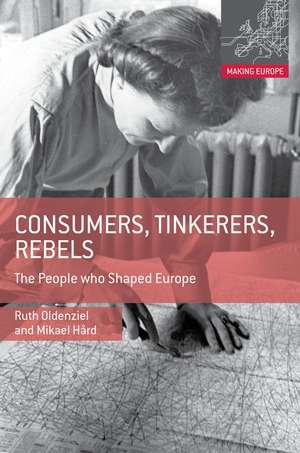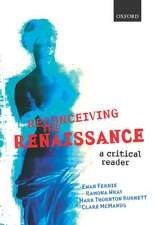Consumers, Tinkerers, Rebels: The People Who Shaped Europe: Making Europe
Autor Ruth Oldenziel, Mikael Hården Limba Engleză Hardback – 17 sep 2013
Certainly inventors, engineers, and politicians played their parts. But in the making of Europe, consumers, tinkerers, and rebels were an unrecognized force - until now. In this book, historians Ruth Oldenziel and Mikael Hård spotlight the people who 'made' Europe - by appropriating technology, protesting for and against it. Using examples from Britain and the Continent, the authors illustrate the conflicts that accompanied the modern technologies, from the sewing machine to the bicycle, the Barbie doll to personal computers. What emerges is a fascinating portrait of how Europeans have lived, from the 1850s to the current century.
| Toate formatele și edițiile | Preț | Express |
|---|---|---|
| Paperback (1) | 252.18 lei 43-57 zile | |
| Palgrave Macmillan UK – 16 sep 2013 | 252.18 lei 43-57 zile | |
| Hardback (1) | 507.08 lei 38-44 zile | |
| Palgrave Macmillan UK – 17 sep 2013 | 507.08 lei 38-44 zile |
Preț: 507.08 lei
Preț vechi: 551.17 lei
-8% Nou
Puncte Express: 761
Preț estimativ în valută:
97.06€ • 105.46$ • 81.58£
97.06€ • 105.46$ • 81.58£
Carte tipărită la comandă
Livrare economică 16-22 aprilie
Preluare comenzi: 021 569.72.76
Specificații
ISBN-13: 9780230308015
ISBN-10: 0230308015
Pagini: 417
Ilustrații: XXII, 416 p. 88 illus.
Dimensiuni: 189 x 246 x 38 mm
Greutate: 1.38 kg
Ediția:2013
Editura: Palgrave Macmillan UK
Colecția Palgrave Macmillan
Seria Making Europe
Locul publicării:London, United Kingdom
ISBN-10: 0230308015
Pagini: 417
Ilustrații: XXII, 416 p. 88 illus.
Dimensiuni: 189 x 246 x 38 mm
Greutate: 1.38 kg
Ediția:2013
Editura: Palgrave Macmillan UK
Colecția Palgrave Macmillan
Seria Making Europe
Locul publicării:London, United Kingdom
Cuprins
Introduction
PART I: THE NINETEENTH CENTURY: SHAPING NEW TECHNOLOGIES
1. Poaching from Paris
2. Creating European Comfort
3. Crossing Borders in Style?
PART II: AFTER THE GREAT WAR: WHO DIRECTS TECHNOLOGY?
4. Bicycling and Driving Europe
5. Eating around the Continent
6. Living in State-sponsored Europe
PART III: BEYOND THE 1960S: USERS EMPOWERED?
7. Saving the Nation, Saving the Earth
8. Toying with America, Toying with Europe
Conclusion
PART I: THE NINETEENTH CENTURY: SHAPING NEW TECHNOLOGIES
1. Poaching from Paris
2. Creating European Comfort
3. Crossing Borders in Style?
PART II: AFTER THE GREAT WAR: WHO DIRECTS TECHNOLOGY?
4. Bicycling and Driving Europe
5. Eating around the Continent
6. Living in State-sponsored Europe
PART III: BEYOND THE 1960S: USERS EMPOWERED?
7. Saving the Nation, Saving the Earth
8. Toying with America, Toying with Europe
Conclusion
Recenzii
"In this entertaining fusion of social and technological history, Ruth Oldenziel and Mikael Hård argue that much of Europe's contemporary culture was created from below after 1850, as active consumers tinkered with and appropriated both machines and processes to change the ways that they worked, traveled, communicated, dressed, and ate. Not politicians or generals but consumers have increasingly shaped the experiences that define what it means to be European." - David E. Nye, author of Technology Matters and America's Assembly Line
"From cycling to the internet, and from Magdeburg to Milan, this rich comparative study reveals how attention to users and the social construction of technology can illuminate the history of modern Europe" - Frank Trentmann, author of Consuming Cultures, Global Perspectives (with John Brewer)
"...an engaging, beautifully illustrated history of Europe's technological inventions, crafts, design, and gadgetry over the last two centuries, but especially of the peoples of Europe - as train riders, sewing machine operators, bicyclists, radio hobbyists, home-makers, hobbyists, and computer mavens. Wide in scope, profound in its questions about the multiplicity of European ways of living, it is also timely background for considering the impact on European technology and craft of global cyber-innovation and the new environment of global manufacturing." - Victoria de Grazia, Columbia University
"Consumers, Tinkerers, Rebels is an impressive achievement. Prioritizing the humble and mundane material culture and positioning consumers and users as The People Who Shaped Europe is a bold and provocative move in a field where the master narratives at least have been dominated by great inventors and entrepreneurs, spectacular innovations and heavy technology. An equally important feature of the book, which is also deeply embedded in the Tensions of Europe network, is the remarkably
broad geographical coverage. Although both authors are North-West Europeans, they have accomplished an outstandingly balanced treatment of west versus east, north versus south and large versus small. Design historians would do well to consult Consumers, Tinkerers, Rebels, both as an example of how transnational history can be written, but also as proof of the potential relevance of design history to a broader academic community." - Journal of Design History
"From cycling to the internet, and from Magdeburg to Milan, this rich comparative study reveals how attention to users and the social construction of technology can illuminate the history of modern Europe" - Frank Trentmann, author of Consuming Cultures, Global Perspectives (with John Brewer)
"...an engaging, beautifully illustrated history of Europe's technological inventions, crafts, design, and gadgetry over the last two centuries, but especially of the peoples of Europe - as train riders, sewing machine operators, bicyclists, radio hobbyists, home-makers, hobbyists, and computer mavens. Wide in scope, profound in its questions about the multiplicity of European ways of living, it is also timely background for considering the impact on European technology and craft of global cyber-innovation and the new environment of global manufacturing." - Victoria de Grazia, Columbia University
"Consumers, Tinkerers, Rebels is an impressive achievement. Prioritizing the humble and mundane material culture and positioning consumers and users as The People Who Shaped Europe is a bold and provocative move in a field where the master narratives at least have been dominated by great inventors and entrepreneurs, spectacular innovations and heavy technology. An equally important feature of the book, which is also deeply embedded in the Tensions of Europe network, is the remarkably
broad geographical coverage. Although both authors are North-West Europeans, they have accomplished an outstandingly balanced treatment of west versus east, north versus south and large versus small. Design historians would do well to consult Consumers, Tinkerers, Rebels, both as an example of how transnational history can be written, but also as proof of the potential relevance of design history to a broader academic community." - Journal of Design History
Notă biografică
Ruth Oldenziel is Full Professor in American and European History at the Eindhoven University of Technology, the Netherlands. Her publications include books and articles in American, European, gender, and technology studies: 'Islands' (in Entangled Geographies edited Gabriel Hecht MIT 2011) Cold War Kitchen (MIT, 2009 co-edited with Karin Zachmann); Making Technology Masculine: (AUP 1999); 'Boys and their Toys in America' (Technology and Culture 1997).
Mikael Hård is Full Professor of History of Technology at Darmstadt University of Technology, Germany. His publications include Hubris and Hybrids: A Cultural History of Technology and Science (Routledge 2005; co-written with Andrew Jamison) and Urban Machinery: Inside Modern European Cities (MIT Press 2008; co-edited with Thomas J. Misa).
Mikael Hård is Full Professor of History of Technology at Darmstadt University of Technology, Germany. His publications include Hubris and Hybrids: A Cultural History of Technology and Science (Routledge 2005; co-written with Andrew Jamison) and Urban Machinery: Inside Modern European Cities (MIT Press 2008; co-edited with Thomas J. Misa).
Textul de pe ultima copertă
Who has decided how Europeans have dressed and dwelled? Traveled and dined? Worked and played? Who, in fact, can be credited with the shaping of Europe?
Certainly inventors, engineers, and politicians played their parts. But in the making of Europe, consumers, tinkerers, and rebels were an unrecognized force - until now. In this book, historians Ruth Oldenziel and Mikael Hård spotlight the people who 'made' Europe - by appropriating technology, protesting for and against it. Using examples from Britain and the Continent, the authors illustrate the conflicts that accompanied the modern technologies, from the sewing machine to the bicycle, the Barbie doll to personal computers. What emerges is a fascinating portrait of how Europeans have lived, from the 1850s to the current century.
Certainly inventors, engineers, and politicians played their parts. But in the making of Europe, consumers, tinkerers, and rebels were an unrecognized force - until now. In this book, historians Ruth Oldenziel and Mikael Hård spotlight the people who 'made' Europe - by appropriating technology, protesting for and against it. Using examples from Britain and the Continent, the authors illustrate the conflicts that accompanied the modern technologies, from the sewing machine to the bicycle, the Barbie doll to personal computers. What emerges is a fascinating portrait of how Europeans have lived, from the 1850s to the current century.























